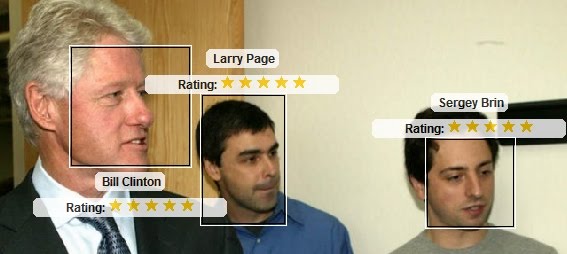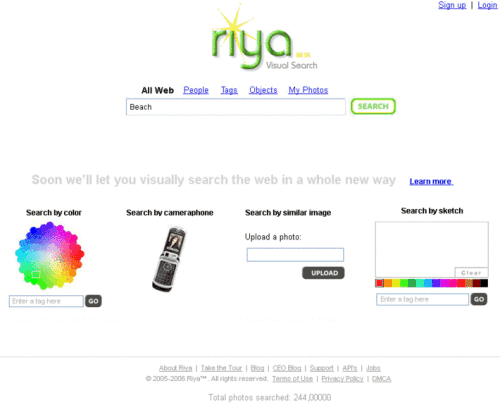
Google acquired Like.com, a product search engine that used visual search to find similar products. "We were the first to bring visual search to shopping, the first to build an automated cross-matching system for clothing, and more," says Munjal Shah, the former CEO of Riya, the company that developed Like.com.
Riya launched in 2005 an impressive software that used face recognition to organize photos. "Riya leveraged facial and text recognition technology with an intelligent interface to help people make sense of the thousands of untitled and untagged photos that are building up on their hard drives." Google launched a similar service 4 years later, using technology from Neven Vision.

Much like Google Wave, Riya's software looked great in demos, but it didn't work well in the real world. The software required a huge collection of photos and each photo had to be uploaded to Riya's servers. "The process is slow; Riya says it takes about 24 hours to upload 4,000 pictures," mentioned the USA Today at that time.
Apparently, Google intended to buy Riya in 2005, but decided to acquire Neven Vision, a company that had a lot of patents on face recognition, photo analysis, visual mobile search. Neven Vision's acquisition helped Google add face recognition to Picasa, advanced features to Google Image Search and visual search to Android.
Why would Google acquire Riya? Probably because the company has many patents on visual recognition and a lot of talented engineers that could work on bigger projects than Like.com. In 2006, Riya planned to launch a visual search engine with support for object recognition, but the company didn't find a way to monetize the product, so it focused on product search, which was more lucrative. Now the team can finally build Riya 2.0:

{ via TechCrunch }
Good thing google is now back in getting things done in the area which they're good at. At least they're elevating they're search engine to a whole new level by having some image recognition patched up to their algorithms. Perhaps in the near future you just need to crop a picture of you and have a search at google and they'll return results to people with similar faces
ReplyDeleteLike.com has always been one of my favorite sites (aside from the visual search) due to their ability to function as the perfect affiliate model.
ReplyDeleteThey rank for everything, but have no physical products. Here is a live video case study from our archives that I performed on like.com essentially breaking down their structure and on page SEO - definitely worth the 11+ minutes and worth watching http://www.seodesignsolutions.com/blog/seo-videos/seo-videos-how-to-discover-competitors-seo-strategies/
via ResourceShelf.com
ReplyDeletehttp://www.resourceshelf.com/2010/08/21/google-acquires-similar-image-database-like-com-what-about-other-similar-image-and-image-recognition-technology-services/
Here's a portion of the ResourceShelf.com post
What's important to know and remember is that Riya/Like.com was not and is not the only player in this space. There were and are still several others. Here are three (not including Face.com whose tech is in use on Facebook.
http://face.com/
1. LTU Technologies
http://ltutech.com/
Has been around for at least 10 years providing visual search and image recognition.
http://en.wikipedia.org/wiki/LTU_Technologies
Commercial (ex. tracking ads, stock photo houses, intellectual property tracking, etc.) and government users. Here's an interesting use of their technology from last month that powered a scavenger hunt of several candy shops. The technologies section of their web site is very useful.
http://ltutech.com/en/technologies
If you want to demo some basic LTU technology they offer a http://www.lookthatup.com/home
mobile app (iPhone, free) and/or an option to upload an image to a web site to find similar images.
2. Online for several months and mentioned on ResourceShelf several times
http://www.resourceshelf.com/2009/11/19/find-similar-images-with-gazopa-beta is GazoPa.
http://www.gazopa.com
It's a "venture project" from Hitachi.
These days GazoPa offers three services (all free).
A) Options to upload, draw, search by keyword, or enter a URL and find similar images. You can also refine results.
http://gazopa.com/
B) GazoPa Style
Looks and acts very similar to Like.com.
http://style.gazopa.com/
C) GazoPa Answers
http://answers.gazopa.com/
"A picture's worth a thousands words. You can upload a picture, use a link, or draw it yourself, and others will help you find answers!"
3) TinEye Reverse Image Search (Free)
http://tineye.com
With TinEye you can learn where an image came from, how it is being used, if modified versions of the image exist, or if there is a higher resolution version.
Note: You are searching against their database of more than 1.6 million images and growing
In this example, you'll see more than 2800 uses of the Abbey Road album cover by The Beatles on the Internet. So, not only is thus database helpful in finding the same image at different resolutions but also modified versions and versions that shouldn't be online for one of many reasons. It's a tool IP researchers love or will love soon.
http://www.tineye.com/search/011f16a6a7a98278717102717d535f5fc9949a10/?page=87&sort=score&order=desc
TinEye is a favorite around here. It's useful, fun, and somewhat addictive.
Fast Fact: You can use Evernote.com to search the text inside of any image you upload to the service. Now, restaurant menus of your favorite places can be saved, searched, and shared.
They're not buying the service, they're "buying" the team, the people behind the service. A proven concept for Google
ReplyDeleteThis is awesome. I cant wait to see this put to good use
ReplyDelete